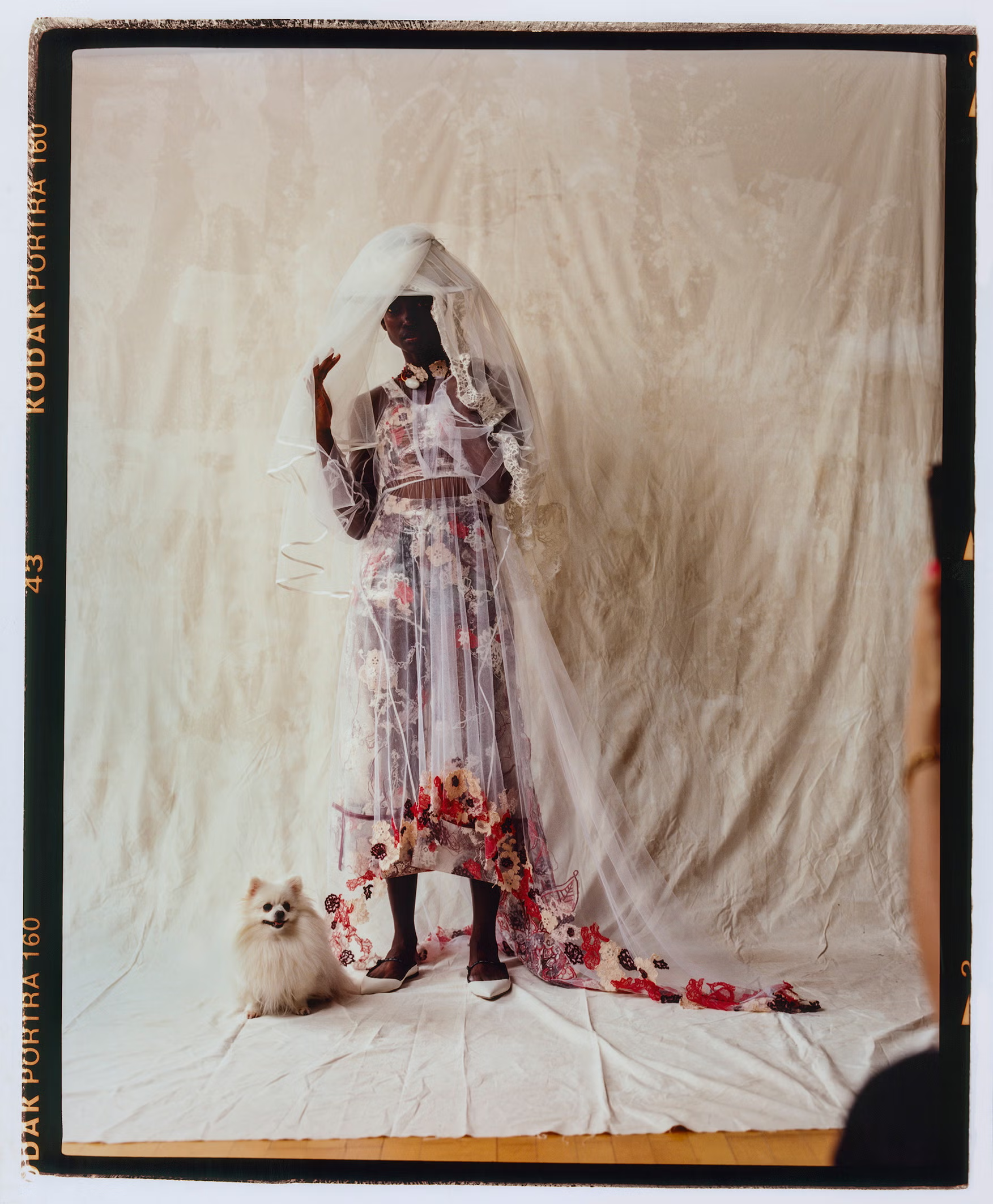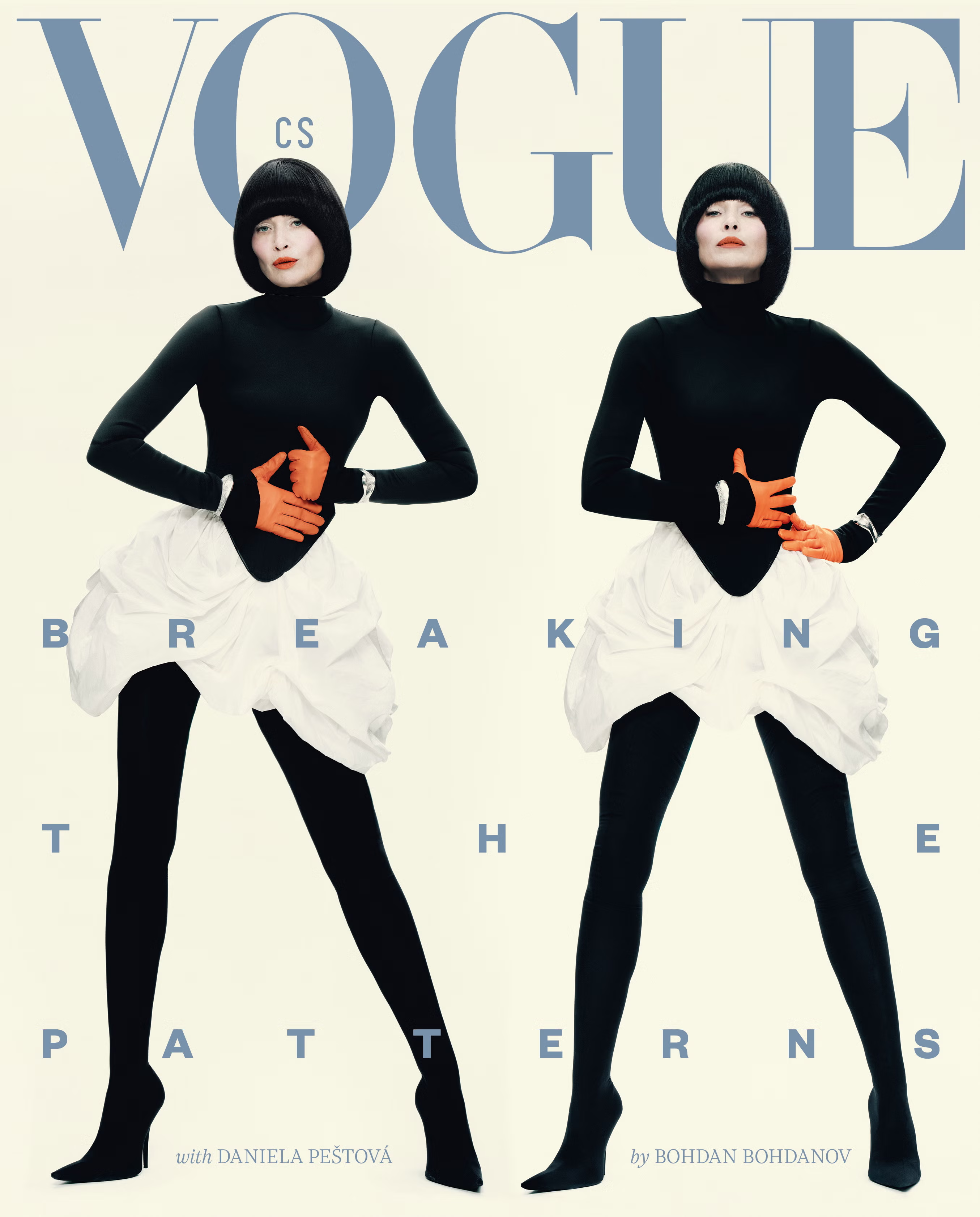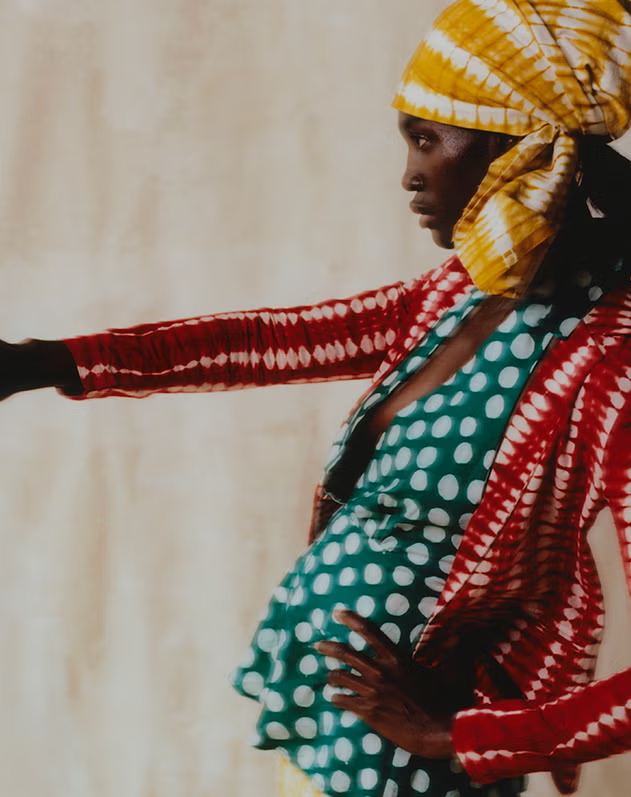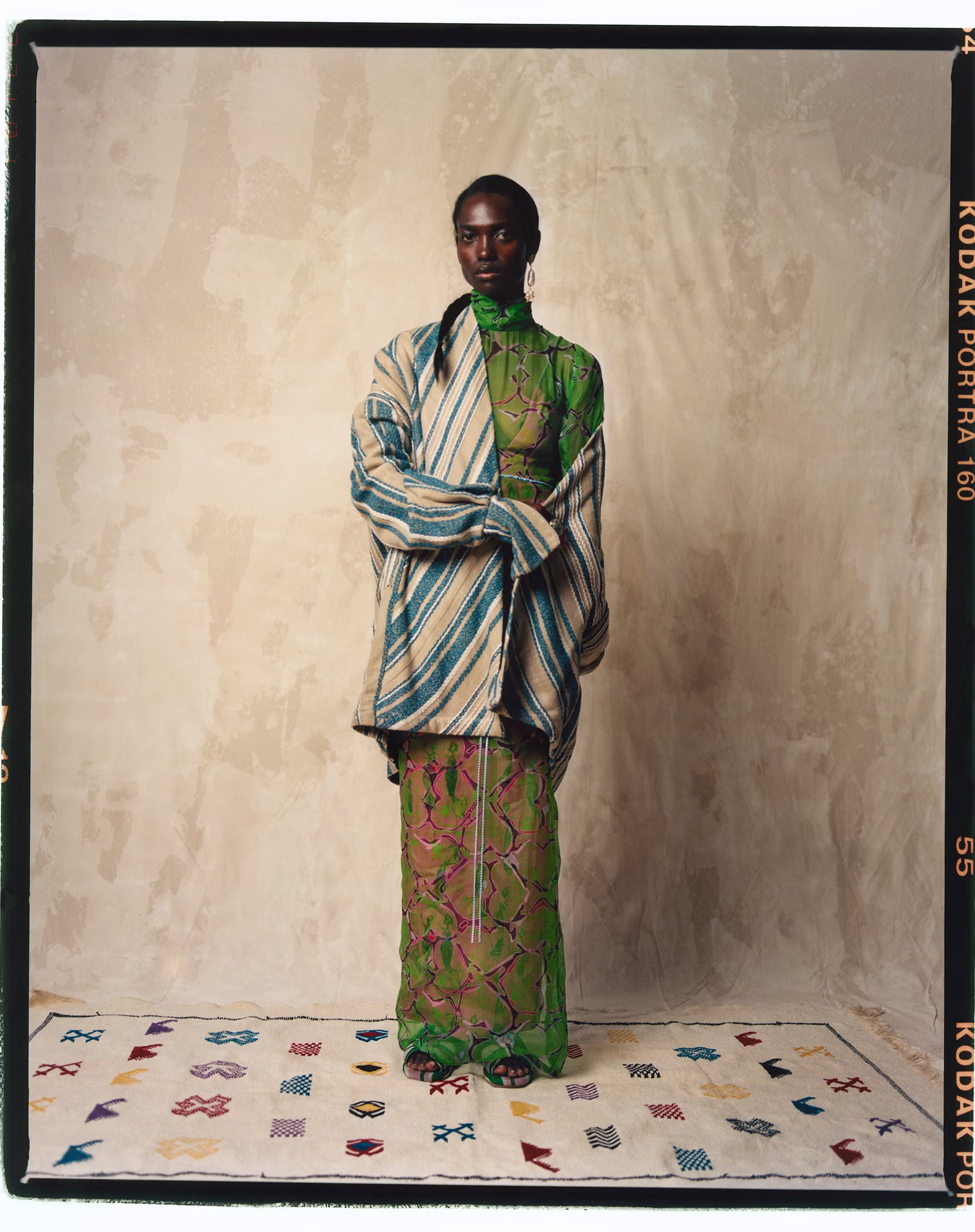Vogue CS in English

Interview with Tolu Coker of Tolu Coker
Ooooota Adepo1. 8. 2020

Foto: Rhys Frampton
Dress, Tolu Coker; veils, The Wedding Club; hat, Maison Michel; shoes, Jimmy Choo; necklace, Ami Doshi Shah (sold at Koibird).
Ooooota: What I love about your work is that you are the totality of a creative. You are an artist. How did you train your ability to see into your ability to create?
Tolu: I commit to the process above everything. When people are around me and helping, very few get it until they see the end result. I almost think the process is more important. Sometimes work which I release has been years of work in the making. Part of my creation is the ‘research’, which could be through journal or diary entries, photos I’ve taken, videos I’ve filmed or experiences I’ve had. I like to let my thoughts develop. The process develops your skill – not just creatively but on a human level.
Ooooota: Do your illustrations influence your fashion designs and your storytelling, particularly with Replica?
Tolu: Every part of my process works interchangeably – it’s really not linear. Stories inform my drawings which inform my prints and inform my fabrics and my silhouettes. Or it could be entirely the other way around depending on where the process leads me. My journals and sketchbooks are initially somewhat erratic but become more refined as I engage in the process of creation. Replica didn’t start as a clothing collection, it started as a documentary because I was genuinely curious to meet strangers across London and Paris who like me, are part of the Black Diaspora. I wanted to step outside of my own world and understand wider perspectives and experiences of a somewhat-dual identity. I spent time with everyone I documented, hanging out with their friends, going to their favourite restaurants, visiting their homes and learning intimate stories of their families in person and through family albums. I needed to physically step into their world to capture their stories in my work. That way I was designing around real people and stories and not just ideals of people who didn’t actually exist.

Tolu Coker
Ooooota: How did Replica shape your understanding of identity, fashion and social perception?
Tolu: I don’t think you can capture the identities of people without engaging in the communities and spaces they belong to. It’s probably why the industry is always in trouble for cultural appropriation. Fashion often focuses on ideals too often, selling desire, exclusivity and dreams. I love a bit of fantasy at times, but everything needs to be in balance.
Fashion designers are not just creative. We are historians and storytellers. We have a huge responsibility in documenting the identity and narrative of society through clothing. One day, future generations will look through history books – or more likely digital archives – and look at the clothing of today as an indicator of the age, societies and cultures we lived in. I always think about this when I’m creating.
Ooooota: Your designs merge artisan craftsmanship and technology. Why have you chosen to create from both ends of the spectrum?
Tolu: With anything, I think adaptability is important. I try to observe a range of different environments and people to understand how society is developing – how we communicate, what we value and what we need to do better. As someone who believes in working in harmony with nature’s existing ecosystems, I definitely think there is so much that we can learn from the virtue of patience, respect for quality and ‘the process’ which artisan craftsmanship techniques embody. I think of craftsmen as divine stewards – they create predominantly with their hands from the appreciation of a necessary process of creation. Bringing this to the forefront of creation is important to me, because my main goal is for a shift in mentality away from our current unsustainable, seasonal desires. When things are quick, easy and cheap they come at the expense of something or someone and I don’t believe we should indulge at the expense of others. But technology is important because it’s a new language that many now speak. You need to speak people’s language to communicate and reach them and I find people are curious when I document and actually show my process – it sparks important conversation. I try to do this whilst maintaining the integrity of what my work stands for – it’s not always easy finding the balance.
Ooooota: Describe your most recent collection. What does it challenge in identity politics? How has it evolved from your previous work as a designer?
Tolu: Juvenile Consciousness had a lot to do with my childhood and the celebration of black joy and cultural capital. As an adult I have realised that much of my development and growth comes from unlearning, rather than learning. The ‘consciousness’ I had as a child is part of the mindset I want to take into my future. I wasn’t raised financially rich, but I always felt rich in culture. It wasn’t until I went to boarding school that I really felt any sense of lack - I didn’t realise we were ‘broke’ because as a child you have an innocence and naivety which is really pure. You just want to explore and have fun and express and live in the present. But I also came from an incredibly community-centred environment that appreciated black cultural capital so I’ve always viewed money as being only as good as what money can buy – money is the middleman. I feel like my childhood, my parents and my peers played a huge part in shaping what I feel is possible for myself and others in my community, despite the challenges of our environment. I’m forever grateful for that.
Council Estate kids and Black kids have always been one of my biggest inspirations and some of the greatest pioneers of culture - from music, to style, to resourcefulness and even intellect. Some of the greatest minds I know are people that society looks down upon, there’s a stigma attached to coming from my ‘type’ of community, so whenever I am privileged to have a platform, those are the voices and stories I want to elevate in that space. That was Juvenile Consciousness.
Ooooota: You’ve spoken about how the individuality and natural skillset of an artist/designer is what he/she needs to develop to become remarkable. How is this best achieved whilst remaining open to inspiration?
Tolu: Be human. I know that sounds so simple but in the age of technology and hyper-visibility, I think so many of us forget how to actually be human and interact in real life. There is inspiration in everything. I’m rarely inspired by other design or designers, but by other people, real life connections, conversations and experiences. Sometimes music will inform my thoughts and create a whole vision; sometimes it's a film, a nature walk or a mentally stimulating conversation. How can we be inspired or even be individual without experiencing?
Being human is also realising that good things take time. We’re obsessed with instant gratification, relevance and ‘being first’. I think everything needs to slow down and we need to invest time into our processes to develop our craft. We are not robots and we need to engage all of our senses in creating. Technology can be a great tool, but I think convenience culture is robbing us of our humanity and divine capabilities.
Ooooota: You’ve had some incredible commissions from Tate Modern and H&M Conscious Collection. How did those happen? Do you want to maintain this institutional connection as you grow as a designer?
Tolu: The Tate commission was incredible; it was my first ever commission. They paid up and gave me free reign to get on with it. I posted some illustration work I did on Facebook, someone saw my work and messaged me about the project. I was in my first year of university, so it was really exciting. The Conscious Collection project was through university – I can’t actually call it a commission because they didn’t pay anything. That project is on the wrong part of my website.
I lecture at UAL now, in addition to running my brand. Education is an important tool especially in terms of balancing equity amongst communities. I’ll keep the institutional connection as long as it serves the purpose of aiding changes I want to see, but I’m very conscious about shifting the dynamic of my relationship with institutions. I’ve been very intentional with my boundaries and approaches to education – a lot needs to change within it and I’m not waiting for someone else to do it.
Ooooota: Have you found that the fashion industry is sufficiently collaborative and accommodating of young designers?
Tolu: No. I’ll admit that they’re great at marketing it to look that way though.
Ooooota: As a designer of African descent, do you have plans to develop your brand in Africa with Africans?
Tolu: Yes!
Ooooota: What can the fashion industry do to better support young talent?
Tolu: For a start, be honest. There needs to be honesty about the depth of work that still needs to be done, from the top down, and that’s just a start. I think that a lot of pressure is placed on young talent to be the example of change, but young people generally have not held institutional power – it's a great way for those with power to evade responsibility. There is still so much gatekeeping across the industry from many who have vested interest in things remaining the same. I don’t think it’s limited to fashion, but our industry is definitely somewhat in denial of the extent to which it supports young talent. For many, there is really no incentive to change and that is why we are seeing so many young people forcing the hand of fashion’s traditions, starting their own brands and businesses and shifting outside of the expected modes of operation - particularly talent from non-Eurocentric cultures and backgrounds that lack the same equity and access as their peers. And when I say support, I don’t mean lip service and exposure in press or consistently unpaid opportunities, because that in itself has a domino effect. If we expect young talent to improve the industry, what we invest in them today are tools they need to implement change. Young people have bills to pay and businesses to run too and unfortunately exposure just does not cut it anymore. I’m all about people putting their money where their mouths are. As much as fashion is a creative practice, it’s an industry and enterprise requires capital. That’s the investment industry needs to make in young talent from a vast pool of backgrounds, if they hope to see any sort of change.



